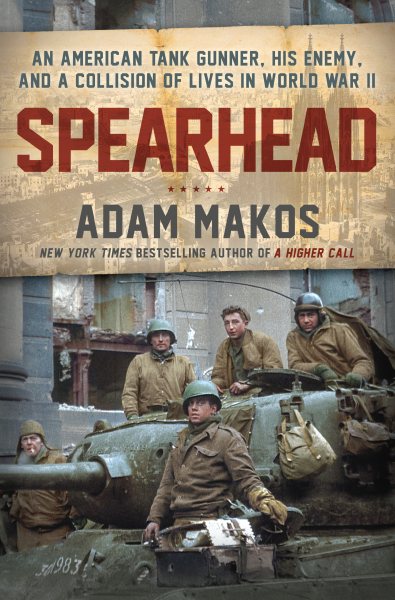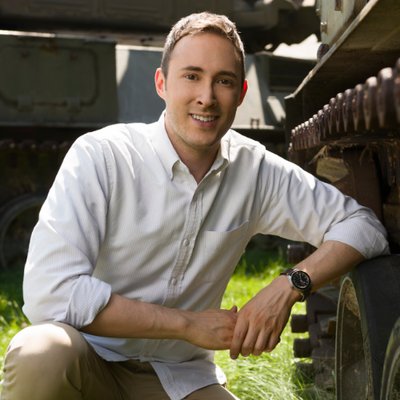Interview by Jana Hoops. Special to the Clarion-Ledger Sunday print edition (February 24). Click here to read this article on the Clarion-Ledger’s website.
It was Adam Makos’ grandfathers’ service in World War II that inspired a career for their grandson, leading to Makos’ deep interest in the military and the American heroes whose stories he feels is his duty to tell.
 The author’s newest book, Spearhead: An American Gunner, His Enemy, and a Collision of Lives in World War II, chronicles not only the surreal story of one young tank gunner’s epic battle in Germany, but that soldier’s deliverance from its trauma that would come some 70 years later.
The author’s newest book, Spearhead: An American Gunner, His Enemy, and a Collision of Lives in World War II, chronicles not only the surreal story of one young tank gunner’s epic battle in Germany, but that soldier’s deliverance from its trauma that would come some 70 years later.
Having earned a spot in what has been called “the top ranks of military writers,” Makos’ previous works include New York Times bestseller A Higher Call and the widely acclaimed Devotion.
Today he lives in Denver.
Your books have highlighted tales of historical military heroes whose stories would have otherwise gone unheard by the American public. Why has this pursuit been a such a passion for you personally?
I love searching for untold stories because it gives my readers a chance to see a new side of World War II, or to meet a new hero, like watching a movie for the first time.
To me, it’s also about justice. To think that some young man risked his life for us, all those years ago, or maybe he made the ultimate sacrifice and bled out on some European battlefield, as one of the heroes of Spearhead actually did, I don’t think it’s right for us to ever forget their names.
How did you find out about Clarence Smoyer, a U.S. Army corporal and tank gunner from Pennsylvania coal country who served in World War II?

Adam Makos
I truly feel I’m “led” to some of these stories, in the spookiest ways. A college buddy told me about Clarence, a quiet hero from his hometown. So one day in 2012, I went up to Clarence’s brick row house and knocked on the door. He welcomed me inside, pulled up a chair at the kitchen table and we talked for a bit before he stunned me with a revelation when he asked, “Would you like to see a letter from the German I fought against?” He was in touch with his former enemy.
Smoyer’s defining moment of the war was a dramatic showdown in Cologne, Germany, between the newfangled American M-26 Pershing “Super Tank” he commanded and the fiercely infamous German Panther tank–a 1945 duel that was, almost unbelievably, captured on film. What was it about his story that compelled you to meticulously research and document it in Spearhead?
Before I met him, I knew about Clarence’s remarkable, Wild West-style tank duel in the street of Cologne. It’s considered one of the most famous actions of World War II, because it was caught on film. Now, anyone can watch it with the click of a mouse button.
But even putting the reader into the middle of that duel, two tanks quick-drawing on each other, 75 yards apart, wasn’t enough to fill a book. It was the deeper, human story that drew me to write Spearhead. Our World War II tank crewmen faced a terrible reality every time they started their engines.
The first tank always gets hit.
That was the nature of tank combat on the Western Front in early 1945. The Germans were on the defense; they could dig in and wait for our guys to come over the hill or around the bend. They could wait to fire until the first American tank rolled into their crosshairs.
So to go first took guts, because that guy was probably going to get hit. When Clarence was assigned the Pershing, a deadly new role fell to him: now, his tank would go first, in every battle.
So I asked myself: Why would any man saddle up for that? Why did Clarence? And the answer was quite profound. He did it to keep his buddies safe. He told himself: We have the biggest gun, we belong out front.
You recount Smoyer’s disturbing decades-long bout with PTSD, and how he finally decided to face it. Explain how this unlikely outcome (of meeting his former enemy in person in their later years) was such a defining chapter in his life.
Like many veterans, Clarence came home and buttoned-up his memories of the war and never aired out the troubling things he’d seen.
So, in his later years, when the memories resurfaced, there was no one left to talk with–all of the men from his crew had passed. There was just one man he could turn to, who had seen the same horrors in Cologne, but from the other end of the street. This man had been his enemy (in the tank duel), Gustav Schaefer.
When Clarence returned to Cologne in 2013 and sat down to talk with Gustav, his former enemy proved to be his saving grace. Talking. It’s what helped him put his ghosts to rest. And he emerged from the ordeal with a new friend. He and Gustav called each other war buddies. They used to exchange Christmas cards and letters. They even Skyped on the computer, talking face to face.
It’s a one in a million chance that they’d have found each other, 70 years after they fought. Then to have actually met, with Clarence flying across the ocean and Gustav driving from northern Germany. And then for them to become inseparable friends? You couldn’t script a better ending to a war story.
Any plans for your next book?
I do have a new World War II book in the works, likely the last I’ll write while veterans are alive to share their stories. For now, however, I’m just enjoying my time celebrating the heroes of Spearhead.
Clarence is 95. Buck Marsh, the GI who used to ride into battle on Clarence’s tank, he’s 95, and he’s coming with me to Jackson, to our signing at Lemuria Books on March 1. For now, I just want to throw a big party for these heroes, to let people meet them and shake their hands, and realize how lucky we are to still have them, 75 years later.
Adam Makos (and Buck Marsh) will be at Lemuria on Friday, March 1, at 5:00 to sign copies of and discuss Spearhead. Lemuria has chosen Spearhead as its February 2019 selection for its First Editions Club for Nonfiction.


Comments are closed.